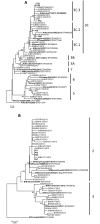Long-Term Shedding of Influenza Virus, Parainfluenza Virus, Respiratory Syncytial Virus and Nosocomial Epidemiology in Patients with Hematological Disorders
- PMID: 26866481
- PMCID: PMC4750950
- DOI: 10.1371/journal.pone.0148258
Long-Term Shedding of Influenza Virus, Parainfluenza Virus, Respiratory Syncytial Virus and Nosocomial Epidemiology in Patients with Hematological Disorders
Abstract
Respiratory viruses are a cause of upper respiratory tract infections (URTI), but can be associated with severe lower respiratory tract infections (LRTI) in immunocompromised patients. The objective of this study was to investigate the genetic variability of influenza virus, parainfluenza virus and respiratory syncytial virus (RSV) and the duration of viral shedding in hematological patients. Nasopharyngeal swabs from hematological patients were screened for influenza, parainfluenza and RSV on admission as well as on development of respiratory symptoms. Consecutive swabs were collected until viral clearance. Out of 672 tested patients, a total of 111 patients (17%) were infected with one of the investigated viral agents: 40 with influenza, 13 with parainfluenza and 64 with RSV; six patients had influenza/RSV or parainfluenza/RSV co-infections. The majority of infected patients (n = 75/111) underwent stem cell transplantation (42 autologous, 48 allogeneic, 15 autologous and allogeneic). LRTI was observed in 48 patients, of whom 15 patients developed severe LRTI, and 13 patients with respiratory tract infection died. Phylogenetic analysis revealed a variety of influenza A(H1N1)pdm09, A(H3N2), influenza B, parainfluenza 3 and RSV A, B viruses. RSV A was detected in 54 patients, RSV B in ten patients. The newly emerging RSV A genotype ON1 predominated in the study cohort and was found in 48 (75%) of 64 RSV-infected patients. Furthermore, two distinct clusters were detected for RSV A genotype ON1, identical RSV G gene sequences in these patients are consistent with nosocomial transmission. Long-term viral shedding for more than 30 days was significantly associated with prior allogeneic transplantation (p = 0.01) and was most pronounced in patients with RSV infection (n = 16) with a median duration of viral shedding for 80 days (range 35-334 days). Long-term shedding of respiratory viruses might be a catalyzer of nosocomial transmission and must be considered for efficient infection control in immunocompromised patients.
Conflict of interest statement
Figures





References
-
- Avetisyan G, Mattsson J, Sparrelid E, Ljungman P. Respiratory syncytial virus infection in recipients of allogeneic stem-cell transplantation: a retrospective study of the incidence, clinical features, and outcome. Transplantation 2009;88: 1222–1226. - PubMed
-
- Chemaly RF, Ghosh S, Bodey GP, Rohatgi N, Safdar A, Keating MJ, et al. Respiratory viral infections in adults with hematologic malignancies and human stem cell transplantation recipients: a retrospective study at a major cancer center. Medicine (Baltimore) 2006;85: 278–287. - PubMed
-
- Falsey AR, Hennessey PA, Formica MA, Cox C, Walsh EE. Respiratory syncytial virus infection in elderly and high-risk adults. N Engl J Med 2005;352: 1749–1759. - PubMed
-
- Renaud C, Xie H, Seo S, Kuypers J, Cent A, Corey L, et al. Mortality rates of human metapneumovirus and respiratory syncytial virus lower respiratory tract infections in hematopoietic cell transplantation recipients. Biol Blood Marrow Transplant 2013;19: 1220–1226. 10.1016/j.bbmt.2013.05.005 - DOI - PMC - PubMed
Publication types
MeSH terms
LinkOut - more resources
Full Text Sources
Other Literature Sources
Medical

